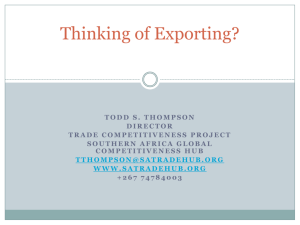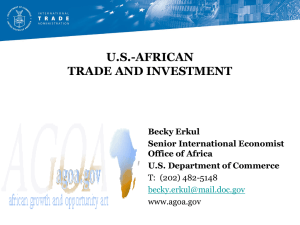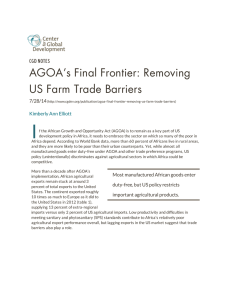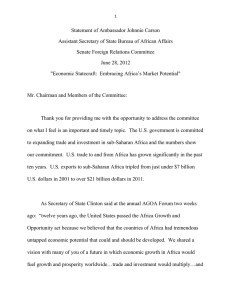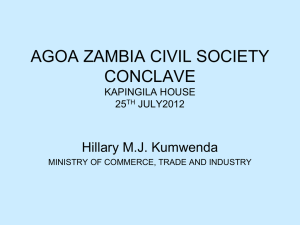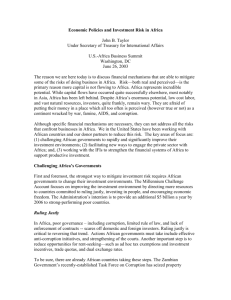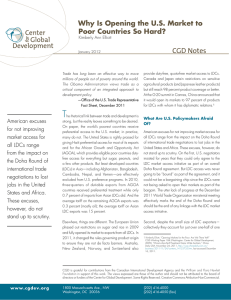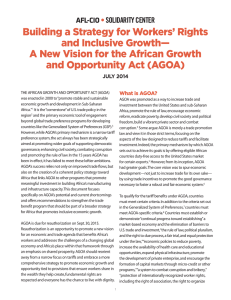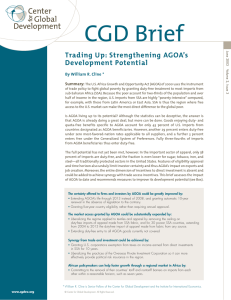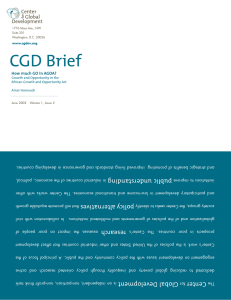Reviving AGOA CGD Brief
advertisement
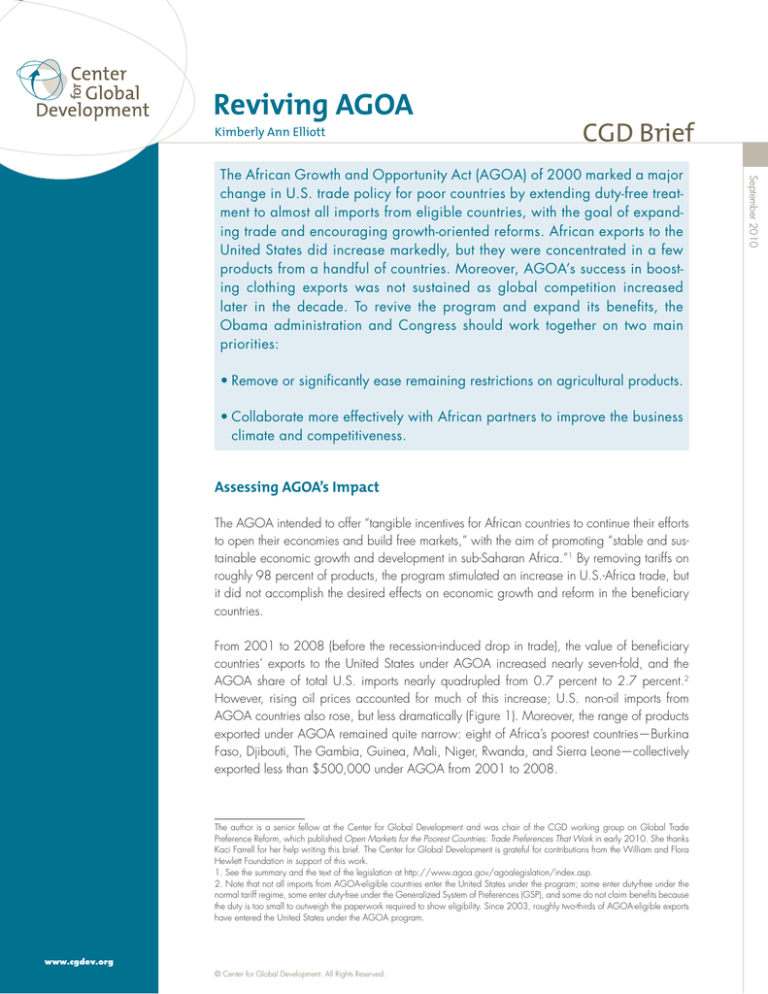
Reviving AGOA Kimberly Ann Elliott CGD Brief • Remove or significantly ease remaining restrictions on agricultural products. • Collaborate more effectively with African partners to improve the business climate and competitiveness. Assessing AGOA’s Impact The AGOA intended to offer “tangible incentives for African countries to continue their efforts to open their economies and build free markets,” with the aim of promoting “stable and sustainable economic growth and development in sub-Saharan Africa.”1 By removing tariffs on roughly 98 percent of products, the program stimulated an increase in U.S.-Africa trade, but it did not accomplish the desired effects on economic growth and reform in the beneficiary countries. From 2001 to 2008 (before the recession-induced drop in trade), the value of beneficiary countries’ exports to the United States under AGOA increased nearly seven-fold, and the AGOA share of total U.S. imports nearly quadrupled from 0.7 percent to 2.7 percent.2 However, rising oil prices accounted for much of this increase; U.S. non-oil imports from AGOA countries also rose, but less dramatically (Figure 1). Moreover, the range of products exported under AGOA remained quite narrow: eight of Africa’s poorest countries—Burkina Faso, Djibouti, The Gambia, Guinea, Mali, Niger, Rwanda, and Sierra Leone—collectively exported less than $500,000 under AGOA from 2001 to 2008. The author is a senior fellow at the Center for Global Development and was chair of the CGD working group on Global Trade Preference Reform, which published Open Markets for the Poorest Countries: Trade Preferences That Work in early 2010. She thanks Kaci Farrell for her help writing this brief. The Center for Global Development is grateful for contributions from the William and Flora Hewlett Foundation in support of this work. 1. See the summary and the text of the legislation at http://www.agoa.gov/agoalegislation/index.asp. 2. Note that not all imports from AGOA-eligible countries enter the United States under the program; some enter duty-free under the normal tariff regime, some enter duty-free under the Generalized System of Preferences (GSP), and some do not claim benefits because the duty is too small to outweigh the paperwork required to show eligibility. Since 2003, roughly two-thirds of AGOA-eligible exports have entered the United States under the AGOA program. www.cgdev.org © Center for Global Development. All Rights Reserved. September 2010 The African Growth and Opportunity Act (AGOA) of 2000 marked a major change in U.S. trade policy for poor countries by extending duty-free treatment to almost all imports from eligible countries, with the goal of expanding trade and encouraging growth-oriented reforms. African exports to the United States did increase markedly, but they were concentrated in a few products from a handful of countries. Moreover, AGOA’s success in boosting clothing exports was not sustained as global competition increased later in the decade. To revive the program and expand its benefits, the Obama administration and Congress should work together on two main priorities: Figure 1. U.S. Imports under AGOA September 2010 60,000 95.6 Million dollars 50,000 40,000 69.2 30,000 60.3 49.9 20,000 22.7 23.5 27.1 2002 2003 34.6 10,000 0 2001 Petroleum (SITC 33) 2004 2005 Apparel (SITC 84) 2006 All other 2007 2008 Crude oil price Source: U.S. International Trade Commission, Dataweb. Overall, 90 percent of exports under AGOA are petroleum products.3 Of the $3.5 billion in non-oil AGOA exports in 2008, about $2 billion were automobiles manufactured in South Africa and just over $1 billion was clothing, mostly from Kenya, Lesotho, Madagascar (since declared ineligible because of a coup), Mauritius, and Swaziland. But clothing exports fell sharply after 2005, when the system of global quotas on textiles and clothing under the Multi-Fiber Arrangement expired. AGOA textile exports showed signs of stabilizing after the United States and other importers imposed temporary restrictions on Chinese textile exports in early 2006, but they plummeted again when the global recession hit in 2008 (Figure 2). The restrictions on Chinese exports expired at the end of 2008, exacerbating pressures on the African clothing exporters. The exclusion of key agricultural products is a serious gap in the AGOA program. Although agriculture provides livelihoods for roughly two-thirds of all Africans, total exports of food, beverages, and tobacco products from AGOA-eligible 3. Some argue that petroleum should be removed from AGOA eligibility, but the average tariff on crude is tiny and has little impact on either the volume or source of U.S. imports. countries grew just 5 percent annually from 2001 to 2009. Moreover, these exports exceeded $150 million only once during that period. That is partly because many agricultural exports receive duty-free treatment under normal trade rules, and also because many African exporters cannot comply with U.S. food, animal, and plant safety regulations.4 For sugar, tobacco, and peanut exporters, however, tight restrictions on access to the U.S. market constitute a serious barrier. In addition, U.S. restrictions on imports of sugar and dairy products effectively discourage African cocoa exporters from processing cocoa beans into chocolate and other value-added products. Key Questions for AGOA’s Future Some AGOA supporters argue that other rich countries should copy the U.S. program while discouraging the United States from extending similar benefits to other similarly poor countries. 4. Charlotte Hebebrand, “Horticultural Exports from AGOA Countries to the U.S.: Challenges and Considerations,” IPC Policy Focus (Washington: International Food & Agricultural Trade Policy Council, 2010). Figure 2. U.S. Textile and Apparel Imports from Top AGOA Exporters September 2010 2,000 1,800 Lesotho Madagascar Kenya Swaziland Mauritius South Africa Others 1,600 Million dollars 1,400 1,200 1,000 800 600 400 200 0 1999 2000 2001 2002 2003 2004 2005 2006 2007 2008 2009 2010* *2010 is extrapolated from data for the first five months of the year. Source: U.S. Department of Commerce, Office of Textiles and Apparel, Trade Data. Should AGOA Be “Super-Sized”? Should the United States Extend AGOA Development economist Paul Collier and others propose that additional rich countries should adopt AGOA. The details are unclear but important because most rich countries have preference programs that already provide duty-free, quotafree market access for most African exports; in some cases, they offer better access than under AGOA. For example, Canada’s program provides nearly complete product coverage and a flexible rule of origin for determining an export’s eligibility. The one clear advantage of the AGOA program is its rule of origin for clothing exports, which is far easier to meet than the rule used by the European Union (EU).5 The EU, however, provides access for agricultural products that the United States does not. Both the EU and Canadian programs are more stable and predictable than AGOA because they are authorized for long periods and are not tied to numerous political conditions. A lengthy negotiation to globalize AGOA is not ideal: poor African countries would derive greater benefits if the United States adopted full product coverage and the EU adopted AGOA’s rules of origin. Benefits to Other Poor Countries? 5. For more on rules of origin see CGD Working Group on Global Trade Preference Reform, Open Markets for the Poorest Countries: Trade Preferences That Work, (Washington: Center for Global Development, 2010). African apparel exporters are concerned that extending duty-free, quota-free market access to other least developed countries would further undermine their competitive position. Most of their concern revolves around Bangladesh and Cambodia, which in 2009 were the fifth and eighth largest sources of U.S. imports, respectively. Under current U.S. trade rules, however, Bangladesh and Cambodia must compete on the same playing field as China, despite having far lower levels of development. In addition, 12 other Asian least developed countries receive little or no preferential access in the U.S. market, including Afghanistan, Laos, Nepal, and Yemen. Imposing ceilings on select product lines where Bangladesh and Cambodia compete directly with the African suppliers may be a reasonable response to African concerns, but excluding them and these other poor countries entirely is difficult to justify, especially considering that the United States committed to do so under the Millennium Development Goals. Global Development works to reduce global poverty and inequality through rigorous research and active engagement with the policy community to make the world a more The Center for prosperous, just, and safe place for us all. The policies and practices of the United States and other rich countries, the emerging powers, and international institutions and corporations have significant impacts on the developing world’s poor people. We aim to improve these policies and practices through research and policy engagement to expand opportunities, reduce inequalities, and Two Recommendations to Revive AGOA The future for AGOA—and for Africa—lies not in avoiding competition, but in meeting it head-on. The United States should act immediately to provide duty-free, quota-free market access to all least developed countries on “essentially all products,” as the UN Millennium Declaration urges. With such improvements in place, the United States should take a leadership role in pushing other rich countries, including the European Union and the emerging markets, such as India and China, to improve their preference programs for least developed countries, including those in Africa.6 The United States should take two additional steps to strengthen its commitment to African development. First, duty-free, quota-free access that eliminates restrictions on sugar and other agricultural exports would primarily benefit African exporters. If this is politically unobtainable in the United States because of pressure from the farm lobby, policymakers should increase access for African exporters within existing restrictions by • expanding existing quotas for African exporters; • renegotiating current quota allocations to include additional African countries; and 6. Research suggests that additional access to the Indian market would significantly benefit African LDCs. See Antoine Bouet et al., “The Costs and Benefits of Duty-Free, Quota-Free Market Access for Poor Countries: Who and What Matters,” CGD Working Paper 206 (Washington: Center for Global Development, 2010). improve lives everywhere. • changing how quotas are administered to make them easier to fill.7 Second, the United States should increase financial and technical resources for institutional capacity building and private sector development in Africa, including trade facilitation. As much as possible, this should be done in ways that emphasize mutual accountability, as recommended in two recent CGD publications. The first publication proposes the creation of a “doing business facility” that would reward countries taking steps to facilitate business creation and growth by providing additional resources to expedite reform.8 The second calls on donors to help reforming governments underwrite “service guarantees” for businesses. These guarantees would be similar to existing investment risk insurance products provided by the U.S. Overseas Private Insurance Corporation or the World Bank’s International Finance Corporation, but they would be available to both local and foreign investors and could cover areas such as customs clearance, licensing, and power supply.9 By providing some assurance that reforms will be sustainable, these proposals would help draw private investors to Africa and reassure donors that their aid dollars are being used effectively. 7. See David Skully, “U.S. Tariff Rate Quotas and AGOA Market Access” (IPC Policy Focus, Washington: International Food & Agricultural Trade Policy Council, 2010). 8. The Supporting Business Climate Reforms Working Group, A Doing Business Facility: A Proposal for Enhancing Business Climate Reform Assistance (Washington: Center for Global Development, 2010), www.cgdev.org/content/publications/ detail/1423783. 9. Vijaya Ramachandran, Alan Gelb, and Manju Kedia Shah, “Africa’s Private Sector: What’s Wrong with the Business Environment and What to Do About It,” CGD Brief (Washington: Center for Global Development, 2009), www.cgdev.org/content/ publications/detail/1421337.
